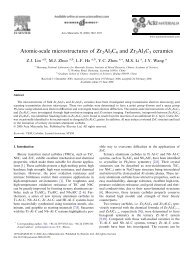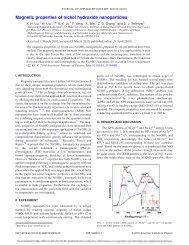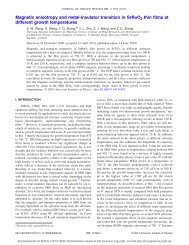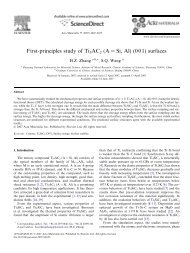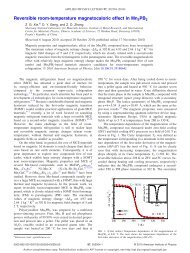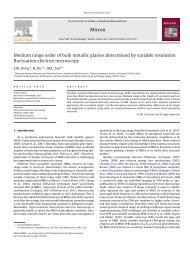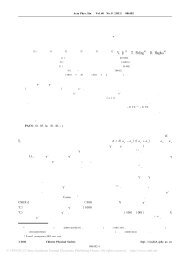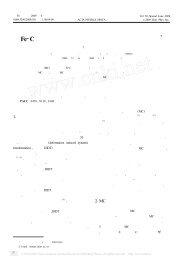Controlled hydrogen generation by reaction of aluminum/sodium ...
Controlled hydrogen generation by reaction of aluminum/sodium ...
Controlled hydrogen generation by reaction of aluminum/sodium ...
You also want an ePaper? Increase the reach of your titles
YUMPU automatically turns print PDFs into web optimized ePapers that Google loves.
international journal <strong>of</strong> <strong>hydrogen</strong> energy 37 (2012) 5811e5816 5815<br />
with the system using deionized water, the system using sea<br />
water exhibits an around 10% increase on HG rate and<br />
a slightly shortened induction period. Presumably, the<br />
advantage <strong>of</strong> sea water over the other two types <strong>of</strong> water<br />
originates from the enriched chlorine ions, which may accelerate<br />
the dissolution <strong>reaction</strong> <strong>of</strong> the passivation layer on the<br />
Al surface [18]. Evidently, using water as a <strong>reaction</strong> controlling<br />
agent implies the wide applicability <strong>of</strong> the newly developed<br />
HG system.<br />
3.3. “Start/stop” <strong>hydrogen</strong> <strong>generation</strong> dynamics<br />
Rapid dynamic response to the highly varying <strong>hydrogen</strong><br />
demands is another prerequisite for a practical HG system. In<br />
the present study, we tested the dynamic response property <strong>of</strong><br />
the Al/NaOH/Na 2 SnO 3 /H 2 O system in a discontinuous HG<br />
process, which involves cyclic start/stop <strong>of</strong> water supply to<br />
the reactor containing solid fuel. To avoid the influence <strong>of</strong> fuel<br />
temperature on the HG performance, the reactor was cooled<br />
down to ambient temperature between each stop/start cycle.<br />
As shown in Fig. 7, feeding water into contact with the solid<br />
fuel immediately initiates vigorous H 2 release. In the first two<br />
cycles, the HG <strong>reaction</strong> reaches its maximum rate within<br />
around 1.3 min, and after switching <strong>of</strong>f the water supply, the<br />
HG <strong>reaction</strong> can be terminated within around 1 min. But in the<br />
third cycle, the system exhibits a multi-step HG behavior and<br />
requires a relatively long duration for terminating the HG<br />
<strong>reaction</strong>. Most likely, this should be ascribed to the deteriorated<br />
mass transfer environment, wherein the accumulated<br />
<strong>by</strong>-products block the water from contacting the unreacted Al.<br />
But despite <strong>of</strong> the property degradation, the HG <strong>reaction</strong> in the<br />
third cycle exhibits a maximum rate <strong>of</strong> 450 ml min 1 , which is<br />
75% <strong>of</strong> the level in the first cycle. After three start/stop cycles,<br />
the total HG yield <strong>of</strong> the system reaches up to 93%. In a general<br />
view, the newly developed system shows satisfactory<br />
dynamic response property. This is <strong>of</strong> clear significance for<br />
the design <strong>of</strong> practical <strong>hydrogen</strong> generator.<br />
Using the data obtained from “start/stop” HG dynamics<br />
measurement, we can estimate the power level <strong>of</strong> the newly<br />
developed system. If the new system is combined with<br />
Fig. 7 e “Start/stop” HG dynamics and temperature pr<strong>of</strong>iles<br />
<strong>of</strong> the system composed <strong>of</strong> three pieces <strong>of</strong> solid fuel tablets<br />
(as shown in the inset) and 15 g <strong>of</strong> water. The feeding rate<br />
<strong>of</strong> water was fixed at 2 g min L1 .<br />
a standard proton exchange membrane fuel cell operating at<br />
0.7 V, a HG rate <strong>of</strong> 500 ml min 1 is equivalent to a power level<br />
<strong>of</strong> 40 W. This can meet the power demands <strong>of</strong> some portable<br />
or mobile apparatus. Using the current price <strong>of</strong> primary Al, 2.4<br />
US$ per kg, as a calculation benchmark, the H 2 -production<br />
cost <strong>of</strong> the present system is estimated to be around 21 US$<br />
per kg H 2 [9]. This H 2 -production cost is much lower than<br />
those <strong>of</strong> the chemical <strong>hydrogen</strong> storage systems using boroncontaining<br />
chemicals [2,5].<br />
4. Conclusions<br />
Our study demonstrated a new Al-based <strong>hydrogen</strong> <strong>generation</strong><br />
system, which is composed <strong>of</strong> Al/NaOH/Na 2 SnO 3 solid mixture<br />
and water. As a consequence <strong>of</strong> the pronounced promoting<br />
effects <strong>of</strong> NaOH and Na 2 SnO 3 additives, the on-demand<br />
<strong>hydrogen</strong> <strong>generation</strong> can be readily achieved <strong>by</strong> regulating<br />
the water supply to the solid fuel. The new system possesses<br />
a favorable combination <strong>of</strong> high <strong>hydrogen</strong> <strong>generation</strong> rate,<br />
high fuel conversion, rapid dynamic response and low material<br />
cost, which makes it promising for portable <strong>hydrogen</strong> source<br />
applications. In addition, the use <strong>of</strong> solid fuel in a tablet form<br />
and the adaptability to different types <strong>of</strong> water greatly increase<br />
the applicability <strong>of</strong> the new system. Our study shows the<br />
feasibility <strong>of</strong> achieving high-performance <strong>hydrogen</strong> <strong>generation</strong><br />
using cheap and readily available materials, there<strong>by</strong> laying<br />
a foundation for developing practical <strong>hydrogen</strong> generators.<br />
Acknowledgments<br />
Fig. 6 e Effects <strong>of</strong> the type <strong>of</strong> water on the HG rate (top) and<br />
yield (bottom) <strong>of</strong> the system composed <strong>of</strong> a piece <strong>of</strong> solid<br />
fuel tablet (1 g <strong>of</strong> Al powder/0.2 g <strong>of</strong> NaOH/0.1 g <strong>of</strong> Na 2 SnO 3 )<br />
and 5 g <strong>of</strong> H 2 O.<br />
The financial supports for this research from the National<br />
Basic Research Program <strong>of</strong> China (973 program, Grant No.<br />
2010CB631305), the National Outstanding Youth Science<br />
Foundation <strong>of</strong> China (Grant No. 51125003), the National<br />
Natural Science Foundation <strong>of</strong> China (Grant No. 51071155), the<br />
Natural Science Foundation <strong>of</strong> Liaoning Province (Grant No.<br />
20102231), and the Main Direction Program <strong>of</strong> Knowledge<br />
Innovation <strong>of</strong> CAS are gratefully acknowledged.



